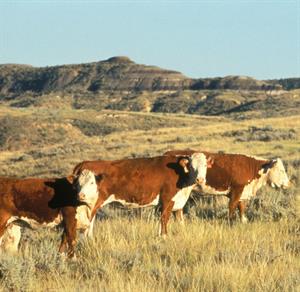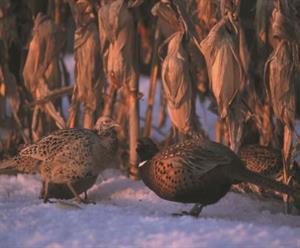Duane Hovorka, IWLA Agriculture Program Director
More than 40 percent of America is privately owned farm and ranch land – that’s more than 900 million acres. In some states, farms and ranches make up over 90 percent of the land base. To provide for healthy fish and wildlife populations, we need to find a place for wildlife on those farms and ranches.
Fortunately, wildlife-friendly farming and ranching practices can go hand in hand with increased profits on America’s farms and ranches.
 Rotational grazing strategies on pasture and rangeland involve moving livestock from parcel to parcel as often as every day. The animals get fresh, nutritious grass and the plants get chomped just once, not grazed down to the ground. With many small parcels (or “paddocks”) to which livestock are moved, plants get a long time to recover without grazing pressure.
Rotational grazing strategies on pasture and rangeland involve moving livestock from parcel to parcel as often as every day. The animals get fresh, nutritious grass and the plants get chomped just once, not grazed down to the ground. With many small parcels (or “paddocks”) to which livestock are moved, plants get a long time to recover without grazing pressure.
This strategy mimics nature, where large herds of grazing bison were always moving from place to place. With a chance to recover, plants produce more forage per acre, allowing ranchers to grow more animals per acre than with “whole field” grazing. That means more profit.
Rotational grazing strategies produce paddocks with very different plant heights. Research shows that birds, pollinators, and other wildlife benefit from the diverse habitat created by this mosaic.

Other wildlife-friendly farming practices can also be profitable. Planting cover crops that keep living plants on the field after harvest builds soil health while providing winter cover and forage for wildlife. Farmers who eliminate tilling, plant cover crops, and diversify their crop rotation can reduce their use of costly chemicals, boosting profits while reducing impacts on wildlife and better protecting the quality of water in nearby streams and wetlands.
Farm Bill conservation programs are our nation’s largest single source of funding for conservation on private farms and ranches, providing over $5 billion per year to help farmers and ranchers be stewards of the land. Those dollars provide wildlife habitat on tens of millions of acres of land.
The current Farm Bill expires in September 2018, and Congress is working on a new five-year Farm Bill. The last time Congress wrote a Farm Bill (in 2014), it cut the budget for conservation for the first time in 30 years. It is critical that the new Farm Bill do more – not less – for America’s fish and wildlife. The League’s agenda for the Farm Bill proposes more funding for conservation and spending existing conservation dollars better.
- The Conservation Reserve Program (CRP) pays farmers to set aside environmentally sensitive land, planting grasses or trees that reduce erosion and provide wildlife habitat. CRP has helped ducks nesting in the northern Great Plains, lesser prairie chickens in Kansas and Oklahoma, trout in the northeast, bobwhite quail in the southeast, and sage grouse in the west. CRP also funds buffer strips, filter strips, and wetland conservation efforts that benefit fish. In 2014, Congress cut the Conservation Reserve Program by 25% to just 24 million acres. The League is working to promoting targeted use of CRP contracts to address the most pressing wildlife and water quality needs in each state or watershed.
- The Agricultural Conservation Easement Program (ACEP) helps farmers restore and protect wetlands and native prairie. The program pays for habitat restoration and for conservation easements that protect the land for the future. Those easements now protect more than 4 million acres of wetlands and prairie, ensuring future generations will enjoy the wildlife and other benefits these resources provide. Congress cut the budget sharply for the program in the 2014 Farm Bill, and the League is working to restore funding to at least $500 million per year.
- The Farm Bill’s major working lands programs are the Conservation Stewardship Program (CSP) and the Environmental Quality Incentives Program (EQIP). CSP rewards whole-farm, integrated conservation systems. EQIP funds individual conservation practices. The League is working to better target these conservation dollars to address the biggest natural resource problems in specific areas. We are also asking that both programs allocate at least 10% of funding for measures that directly benefit fish and wildlife.
America’s fish and wildlife depend on America’s farms and ranches for critical habitat. The 2018 Farm Bill needs to ensure that farmers and ranchers have the tools they need to make a place for wildlife through wildlife-friendly practices and innovative farming and ranching systems.
Learn more about the League's work on the Farm Bill....